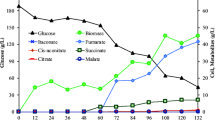Abstract
Ensuring a suitable pH in the culture broth is a major problem in microorganism-assisted industrial fermentation of organic acids. To address this issue, we investigated the physiological changes in Rhizopus oryzae at different extracellular pH levels and attempted to solve the issue of cell shortage under low pH conditions. We compared various parameters, such as membrane fatty acids’ composition, intracellular pH, and adenosine triphosphate (ATP) concentration. It was found that the shortage of intracellular ATP might be the main reason for the low rate of fumaric acid production by R. oryzae under low pH conditions. When 1 g/l citrate was added to the culture medium at pH 3.0, the intracellular ATP concentration increased from 0.4 to 0.7 µmol/mg, and the fumaric acid titer was enhanced by 63 % compared with the control (pH 3.0 without citrate addition). The final fumaric acid concentration at pH 3.0 reached 21.9 g/l after 96 h of fermentation. This strategy is simple and feasible for industrial fumaric acid production under low pH conditions.


Similar content being viewed by others
References
Xu Q, Li S, Huang H, Wen J (2012) Key technologies for the industrial production of fumaric acid by fermentation. Biotechnol Adv 30:1685–1696
Deng Y, Li S, Xu Q, Gao M, Huang H (2012) Production of fumaric acid by simultaneous saccharification and fermentation of starchy materials with 2-deoxyglucose-resistant mutant strains of Rhizopus oryzae. Bioresour Technol 107:363–367
Roa Engel CA (2010) Integration of fermentation and cooling crystallisation to produce organic acids[D]. Delft University of Technology, The Netherlands, pp 46–63
Zhou Z, Du G, Hua Z, Zhou J, Chen J (2011) Optimization of fumaric acid production by Rhizopus delemar based on the morphology formation. Bioresour Technol 102:9345–9349
Roa Engel CA, van Gulik WM, Marang L, van der Wielen LAM, Straathof AJJ (2011) Development of a low pH fermentation strategy for fumaric acid production by Rhizopus oryzae. Enzyme Microbial Technol 48:39–47
Guan N, Liu L, Shin H-D, Chen RR, Zhang J, Li J, Du G, Shi Z, Chen J (2013) Systems-level understanding of how Propionibacterium acidipropionici respond to propionic acid stress at the microenvironment levels: mechanism and application. J Biotechnol 167:56–63
Fozo EM, Kajfasz JK, Quivey RG (2004) Low pH-induced membrane fatty acid alterations in oral bacteria. FEMS Microbiol Lett 238:291–295
Zhou J, Liu L, Chen J (2011) Improved ATP supply enhances acid tolerance of Candida glabrata during pyruvic acid production. J Appl Microbiol 110:44–53
Xu Q, Li S, Fu Y, Tai C, Huang H (2010) Two-stage utilization of corn straw by Rhizopus oryzae for fumaric acid production. Bioresour Technol 101:6262–6264
Ding Y, Li S, Dou C, Yu Y, Huang H (2011) Production of fumaric acid by Rhizopus oryzae: role of carbon–nitrogen ratio. Appl Biochem Biotechnol 164:1461–1467
Varela C, Agosin E, Baez M, Klapa M, Stephanopoulos G (2003) Metabolic flux redistribution in Corynebacterium glutamicum in response to osmotic stress. Appl Microbiol Biotechnol 60:547–555
Ren L-J, Huang H, Xiao A-H, Lian M, Jin L-J, Ji X-J (2009) Enhanced docosahexaenoic acid production by reinforcing acetyl-CoA and NADPH supply in Schizochytrium sp. HX-308. Bioprocess Biosyst Eng 32:837–843
Xu S, Zhou J, Qin Y, Liu L, Chen J (2010) Water-forming NADH oxidase protects Torulopsis glabrata against hyperosmotic stress. Yeast 27:207–216
Rodríguez-Vargas S, Sánchez-García A, Martínez-Rivas JM, Prieto JA, Randez-Gil F (2007) Fluidization of membrane lipids enhances the tolerance of Saccharomyces cerevisiae to freezing and salt stress. Appl Environ Microbiol 73:110–116
Fozo EM, Quivey RG (2004) Shifts in the membrane fatty acid profile of Streptococcus mutans enhance survival in acidic environments. Appl Environ Microbiol 70:929–936
McElhaney RN, Souza KA (1976) The relationship between environmental temperature, cell growth and the fluidity and physical state of the membrane lipids in Bacillus stearothermophilus. Biochim Biophysica Acta (BBA) Biomembranes 443:348–359
Martínez-Muñoz GA, Kane P (2008) Vacuolar and plasma membrane proton pumps collaborate to achieve cytosolic pH homeostasis in yeast. J Biol Chem 283:20309–20319
Zhou J, Liu L, Shi Z, Du G, Chen J (2009) ATP in current biotechnology: regulation, applications and perspectives. Biotechnol Adv 27:94–101
Harris DM, van der Krogt ZA, van Gulik WM, van Dijken JP, Pronk JT (2007) Formate as an auxiliary substrate for glucose-limited cultivation of Penicillium chrysogenum: impact on penicillin G production and biomass yield. Appl Environ Microbiol 73:5020–5025
Acknowledgments
This work was financially supported by the National Natural Science Foundation of China (No. 21106065), the National Basic Research Program of China (No. 2013CB733605), National Science Foundation for Distinguished Young Scholars of China (No. 21225626), and the National High Technology Research and Development Program of China (No. 2011AA02A206).
Author information
Authors and Affiliations
Corresponding author
Rights and permissions
About this article
Cite this article
Liu, Y., Lv, C., Xu, Q. et al. Enhanced acid tolerance of Rhizopus oryzae during fumaric acid production. Bioprocess Biosyst Eng 38, 323–328 (2015). https://doi.org/10.1007/s00449-014-1272-8
Received:
Accepted:
Published:
Issue Date:
DOI: https://doi.org/10.1007/s00449-014-1272-8




